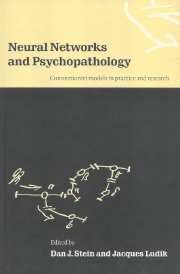Book contents
- Frontmatter
- Contents
- List of contributors
- Preface
- Part one General Concepts
- Part two Clinical disorders
- 7 The nature of delusions: a hierarchical neural network approach
- 8 ‘Produced by either God or Satan’: neural network approaches to delusional thinking
- 9 Neural network modelling of cognitive disinhibition and neurotransmitter dysfunction in obsessive–compulsive disorder
- 10 The fables of Lucy R.: association and dissociation in neural networks
- 11 Neural network analysis of learning in autism
- 12 Are there common neural mechanisms for learning, epilepsy, and Alzheimer's disease?
- Epilogue
- Index
9 - Neural network modelling of cognitive disinhibition and neurotransmitter dysfunction in obsessive–compulsive disorder
from Part two - Clinical disorders
Published online by Cambridge University Press: 12 January 2010
- Frontmatter
- Contents
- List of contributors
- Preface
- Part one General Concepts
- Part two Clinical disorders
- 7 The nature of delusions: a hierarchical neural network approach
- 8 ‘Produced by either God or Satan’: neural network approaches to delusional thinking
- 9 Neural network modelling of cognitive disinhibition and neurotransmitter dysfunction in obsessive–compulsive disorder
- 10 The fables of Lucy R.: association and dissociation in neural networks
- 11 Neural network analysis of learning in autism
- 12 Are there common neural mechanisms for learning, epilepsy, and Alzheimer's disease?
- Epilogue
- Index
Summary
In recent years there has been a dramatic revolution in our conceptualization of obsessive–compulsive disorder (OCD). OCD has long been considered a prototypical psychogenic condition, one that allowed an important window onto the workings of the unconscious mind. The disorder was thought to be relatively uncommon and refractory to treatment. In the last decade or so, however, advances in the neurobiology of OCD have led to a view that this disorder is best understood as one of the neuropsychiatric disorders, with specific brain dysfunction underlying complex behavioural symptoms. Furthermore, OCD is now recognized to be one of the most common psychiatric disorders (Karno et al., 1984; Weissman et al., 1994), and the introduction of novel pharmacotherapeutic and psychotherapeutic interventions has significantly improved its outcome (Baer and Minichiello, 1990; Jenike, 1992).
One of the most interesting aspects of current research on OCD is the new perspective that is being brought to questions about brain–behaviour relationships. Clearly, patients with OCD suffer from psychological symptoms, with anxiety-provoking intrusive thoughts (obsessions) leading to repetitive and ritualistic responses (compulsions). Functional imaging studies, however, demonstrate that these symptoms are mediated by specific dysfunctional brain circuits. Of significant interest is that both medication and psychotherapy lead to normalization of these circuits. Thus, while OCD may involve brain dysfunction, a comprehensive understanding of the condition also requires attention to brain-based emergent psychological structures and processes (Stein and Hollander, 1992).
In order to think about and further study this kind of integration of biological and behavioural data, clinicians and researchers may find it useful to draw on the theoretical constructs and empirical methods of cognitive science.
- Type
- Chapter
- Information
- Neural Networks and PsychopathologyConnectionist Models in Practice and Research, pp. 231 - 247Publisher: Cambridge University PressPrint publication year: 1998
- 2
- Cited by



